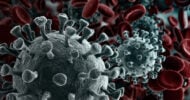by Michael Smith
The number of emergency room visits for nonmedical use of prescription painkillers more than doubled between 2004 and 2008, according to a CDC estimate.
The increase was part of a trend that saw emergency room visits for nonmedical use of all prescription and over-the-counter medications reach the same level as those for abuse of illicit drugs, the agency said in the June 18 issue of Morbidity and Mortality Weekly Report.
One implication of the findings, the agency said, is that “stronger measures to reduce the diversion of prescription drugs to nonmedical purposes are warranted.”
The estimates come from the most recent data available from the Drug Abuse Warning Network (DAWN), which monitors drug-related emergency room visits in a sample of about 220 hospitals. For 2008, data was available from 231 hospitals and was weighted to be representative for the U.S. population.
For the analysis, nonmedical use of a drug was defined as: Taking a higher-than-recommended dose, taking a drug prescribed for another person, drug-facilitated assault, or documented misuse or abuse.
Analysis showed:
* The estimated number of emergency visits for nonmedical use of opioid analgesics increased from 144,600 visits in 2004 to 305,900 in 2008, including a 29% increase during 2007-2008 alone.
* Oxycodone (OxyContin, Roxicodone), hydrocodone, and methadone were the drugs most often involved, and all showed statistically significant increases from 2004 through 2008.
* The estimated number of visits involving nonmedical use of benzodiazepines increased from 143,500 visits in 2004 to 271,700 in 2008, or 89%, including a 24% increase during 2007-2008 alone.
* Several individual benzodiazepines were involved in a significantly increased number of visits, including alprazolam (Xanax), clonazepam (Klonapin), diazepam (Valium), and lorazepam (Ativan, Temesta).
* The sleep aid zolpidem (Ambien) also played a significantly increased role.
The agency said emergency room visits for illicit drugs were about a million a year in 2004 and did not change over time. But the number of visits for nonmedical use of prescription or over-the-counter medications rose from about 500,000 in 2004 to 1 million in 2008.
In 2008, the rates of treatment for nonmedical use of opioids and benzodiazepines rose sharply at about age 17, peaked at ages 21 through 24, and declined after 54. That represents a shift to younger patients, the agency said.
The CDC said the study has several limitations. For one thing, drugs involved might not all be identified and documented, and documentation of drug involvement might have increased over time.
As well, it is possible that information on the motivation for use might be incomplete; the DAWN definition excludes suicide attempts, but some visits might have been the result of such acts.
And, the CDC said, telling the difference between drugs taken for nonmedical and medical reasons is difficult, especially when multiple drugs are involved.
Michael Smith is a MedPage Today North American Correspondent.
Originally published in MedPage Today. Visit MedPageToday.com for more prescription news.









![AI in American medicine [PODCAST]](https://www.kevinmd.com/wp-content/uploads/AI-in-American-medicine-190x100.jpg)
![Sham peer reviews [PODCAST]](https://www.kevinmd.com/wp-content/uploads/Sham-peer-reviews-190x100.jpg)




![A tribute to primary care [PODCAST]](https://www.kevinmd.com/wp-content/uploads/A-tribute-to-primary-care-190x100.jpg)
